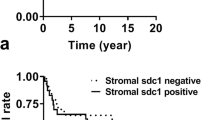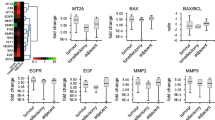Abstract
Background
Syndecan-1 (SDC1) is reported to modulate several key processes of tumorigenesis and to show variable expression in many cancers. The cause of these variations in expression is not known to date. In this study, we compared SDC1 status with clinicopathologic parameters to evaluate the prognostic implications of SDC1 status on squamous cell carcinoma (SCC) of the tonsil.
Methods
In 56 cases of tonsillar SCC, we screened SDC1 expression using immunohistochemistry and analyzed the relationships between SDC1 expression and clinicopathological parameters. To identify the cause of the changes in SDC1 expression seen in tumors, we measured the gene dosage of SDC1 in tumor cells using fluorescent in situ hybridization.
Results
SDC1 expression was found in cancer cells in 36 cases (64.3 %) of tonsillar SCC. It was associated with lymph node metastasis (p = 0.010) and a positive surgical resection margin (p = 0.014). On the other hand, it was not significantly correlated with sex, age, smoking status, degree of differentiation, T stage, or distant metastasis. We could not find any copy-number variation of SDC1 in the cases showing increased SDC1 immunopositivity. In addition, strong SDC1 expression in the tumor cells predicted a shorter overall survival (p = 0.020, log-rank).
Conclusions
We showed that SDC1 expression is associated with N stage and the status of resection margin involvement in SCC of the tonsil. With respect to survival, there were unfavorable outcomes in cases with SDC1 positivity. More studies are needed to better understand the role of SDC1 in the progression and invasiveness of tonsillar SCC.



Similar content being viewed by others
References
Teng YH, Aquino RS, Park PW (2012) Molecular functions of syndecan-1 in disease. Matrix Biol 31:3–16
Rapraeger AC (2001) Molecular interactions of syndecans during development. Semin Cell Dev Biol 12:107–116
Bernfield M, Gotte M, Park PW et al (1999) Functions of cell surface heparan sulfate proteoglycans. Annu Rev Biochem 68:729–777
Anttonen A, Kajanti M, Heikkila P et al (1999) Syndecan-1 expression has prognostic significance in head and neck carcinoma. Br J Cancer 79:558–564
Al-Shibli K, Al-Saad S, Andersen S et al (2010) The prognostic value of intraepithelial and stromal CD3-, CD117- and CD138-positive cells in non-small cell lung carcinoma. APMIS 118:371–382
Anttonen A, Heikkila P, Kajanti M et al (2001) High syndecan-1 expression is associated with favourable outcome in squamous cell lung carcinoma treated with radical surgery. Lung Cancer 32:297–305
Kim YI, Lee A, Lee BH et al (2011) Prognostic significance of syndecan-1 expression in cervical cancers. J Gynecol Oncol 22:161–167
Shimada K, Nakamura M, De Velasco MA et al (2010) Role of syndecan-1 (CD138) in cell survival of human urothelial carcinoma. Cancer Sci 101:155–160
Rasmussen T, Lodahl M, Hancke S et al (2004) In multiple myeloma clonotypic CD38-/CD19+/CD27+ memory B cells recirculate through bone marrow, peripheral blood and lymph nodes. Leuk Lymphoma 45:1413–1417
Huff CA, Matsui W (2008) Multiple myeloma cancer stem cells. J Clin Oncol 26:2895–2900
Alexander CM, Reichsman F, Hinkes MT et al (2000) Syndecan-1 is required for Wnt-1-induced mammary tumorigenesis in mice. Nat Genet 25:329–332
Joensuu H, Anttonen A, Eriksson M et al (2002) Soluble syndecan-1 and serum basic fibroblast growth factor are new prognostic factors in lung cancer. Cancer Res 62:5210–5217
Seidel C, Sundan A, Hjorth M et al (2000) Serum syndecan-1: a new independent prognostic marker in multiple myeloma. Blood 95:388–392
Roh YH, Kim YH, Choi HJ et al (2008) Syndecan-1 expression in gallbladder cancer and its prognostic significance. Eur Surg Res 41:245–250
Parkin DM, Bray F, Ferlay J et al (2005) Global cancer statistics, 2002. CA Cancer J Clin 55:74–108
Moon SH, Choi JY, Lee HJ et al (2012) Prognostic value of (18) F-FDG PET/CT in patients with squamous cell carcinoma of the tonsil: comparisons of volume-based metabolic parameters. Head Neck 35(1):15–22
Lee SY, Park SY, Kim SH et al (2011) Expression of matrix metalloproteinases and their inhibitors in squamous cell carcinoma of the tonsil and their clinical significance. Clin Exp Otorhinolaryngol 4:88–94
Chaturvedi AK, Engels EA, Pfeiffer RM et al (2011) Human papillomavirus and rising oropharyngeal cancer incidence in the United States. J Clin Oncol 29:4294–4301
St Guily JL, Clavel C, Okais C et al (2011) Human papillomavirus genotype distribution in tonsil cancers. Head Neck Oncol 3:6
Patel SG, Shah JP (2005) TNM staging of cancers of the head and neck: striving for uniformity among diversity. CA Cancer J Clin 55:242–58; quiz 261–262, 264
Poulsen M, Porceddu SV, Kingsley PA et al (2007) Locally advanced tonsillar squamous cell carcinoma: treatment approach revisited. Laryngoscope 117:45–50
Lindquist D, Romanitan M, Hammarstedt L et al (2007) Human papillomavirus is a favourable prognostic factor in tonsillar cancer and its oncogenic role is supported by the expression of E6 and E7. Mol Oncol 1:350–355
Mennerich D, Vogel A, Klaman I et al (2004) Shift of syndecan-1 expression from epithelial to stromal cells during progression of solid tumours. Eur J Cancer 40:1373–1382
Mukunyadzi P, Liu K, Hanna EY et al (2003) Induced expression of syndecan-1 in the stroma of head and neck squamous cell carcinoma. Mod Pathol 16:796–801
Hammarstedt L, Dahlstrand H, Lindquist D et al (2007) The incidence of tonsillar cancer in Sweden is increasing. Acta Otolaryngol 127:988–992
Hammarstedt L, Lindquist D, Dahlstrand H et al (2006) Human papillomavirus as a risk factor for the increase in incidence of tonsillar cancer. Int J Cancer 119:2620–2623
Inki P, Joensuu H, Grenman R et al (1994) Association between syndecan-1 expression and clinical outcome in squamous cell carcinoma of the head and neck. Br J Cancer 70:319–323
Ramani VC, Pruett PS, Thompson CA et al (2012) Heparan sulfate chains of syndecan-1 regulate ectodomain shedding. J Biol Chem 287:9952–9961
Vered M, Dayan D, Yahalom R et al. Cancer-associated fibroblasts and epithelial-mesenchymal transition in metastatic oral tongue squamous cell carcinoma. Int J Cancer 127:1356–1362
Ito Y, Yoshida H, Nakano K et al (2003) Syndecan-1 expression in thyroid carcinoma: stromal expression followed by epithelial expression is significantly correlated with dedifferentiation. Histopathology 43:157–164
Maeda T, Desouky J, Friedl A (2006) Syndecan-1 expression by stromal fibroblasts promotes breast carcinoma growth in vivo and stimulates tumor angiogenesis. Oncogene 25:1408–1412
Gotte M, Kersting C, Ruggiero M et al (2006) Predictive value of syndecan-1 expression for the response to neoadjuvant chemotherapy of primary breast cancer. Anticancer Res 26:621–627
Roh YH, Kim YH, Choi HJ et al (2009) Fascin overexpression correlates with positive thrombospondin-1 and syndecan-1 expressions and a more aggressive clinical course in patients with gallbladder cancer. J Hepatobiliary Pancreat Surg 16:315–321
Acknowledgments
This research was supported by the Basic Science Research Program through the National Research Foundation of Korea (NRF), as funded by the Ministry of Education, Science and Technology (2009-0087026).
Conflict of interest
The authors declare that they have no conflict of interest.
Author information
Authors and Affiliations
Corresponding authors
About this article
Cite this article
Lee, S.H., Choi, E.J., Kim, M.S. et al. Prognostic significance of syndecan-1 expression in squamous cell carcinoma of the tonsil. Int J Clin Oncol 19, 247–253 (2014). https://doi.org/10.1007/s10147-013-0552-7
Received:
Accepted:
Published:
Issue Date:
DOI: https://doi.org/10.1007/s10147-013-0552-7




